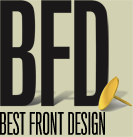By Robert Rubrecht,
Newspaper Association of America


In an effort to attract a greater audience to printed newspapers, specifically at newsstands, newspapers have changed their look through redesigns and single copy editions. The latest newspaper to attempt to attract audiences through a makeover is the Wyoming Tribune Eagle.
The three main goals for the redesign were to increase readership, revenue and single copy sales. Cheyenne experienced a web width reduction and shorter cutoff as a result of a new press installation. This change played a role in creating the new look as well. Several rounds of focus groups were conducted to determine how the company could improve the newspaper for readers and advertisers during the redesign process.
The new design makes a bolder use of color and focuses on just a few elements above the fold. In an effort to determine how the new design would play out in Cheyenne, the newspaper tested the prototype against its own publication and several other local and regional newspapers by placing the newspapers into newsracks to display the above-the-fold portion of the newspaper. The racks were then juxtaposed next to one another. The new design garnered praise from the respondents that content of the main headline and an uncluttered, bold presentation. There have been two schools of thoughts with redesigns with one looking to create numerous points of entry above the fold and the other hoping to capture a reader's attention with one big story and headline to match. This latter tactic was employed by Cheyenne and although it?s still early, Cheyenne is reporting a 15 percent lift year over year as well as the previous week before launch.
According to Alan Jacobson, owner of Brass Tacks Design who engineered the Cheyenne program, the redesign helped dispel one single copy myth, specifically that readers of home delivery editions would not tolerate dramatic change to the front page which is why some media companies produce a separate, unique single copy edition. Other?s have contended that if the redesign builds readership for single copy it would have a similar impact for home delivery, as Jacobson believes.
"In Cheyenne, they're publishing the same edition for both single copy sales and home delivery. The positive response they're getting in Cheyenne proves that subscribers will tolerate - and prefer - a more dramatic presentation intended to boost single-copy sales."
There doesn?t appear to be any revolt occurring in Wyoming. Thus far only four subscribers have stopped delivery of the paper citing the redesign as their reason for doing so. The positive comments have outnumbered the negative and most of the negative comments center on the weather package which was not touched during the redesign.
Whenever undertaking a change of this magnitude it impacts every department within the organizational structure and can be the source of bruised egos and frayed nerves. It is important to achieve buy-in throughout the organization, by producing numbers before the change and tracking readership and sales trends, in some cases for several years in advance, can help demonstrate the need for change. Measuring the results after the change will help determine if the project was a success or failure. In any event, it?s important to measure results and have everyone pushing in the same direction because any act of sabotage could derail the entire project and waste the precious resources of the organization.
In Cheyenne?s case, executive editor Reed Eckhardt led the newsroom in a new direction. Working closely with managing editor Brian Martin and two assistant managing editors, Kevin Wingert and Kiah Staley they have changed the front page story process. VP Sales & Marketing Scott Walker provided the leadership to the other departments which included the construction of a new press facility.
Of course the process is still early and a lot can change over the course of the next several months. The readers hold the key. Will they continue to buy the revamped product or are they experiencing a brief infatuation with a newly dressed up paper? Will the headlines continue to be bold and thought-provoking or does the newsroom revert to previous story treatment and traditional thinking? Only with time will the issue of sustainability be answered.


